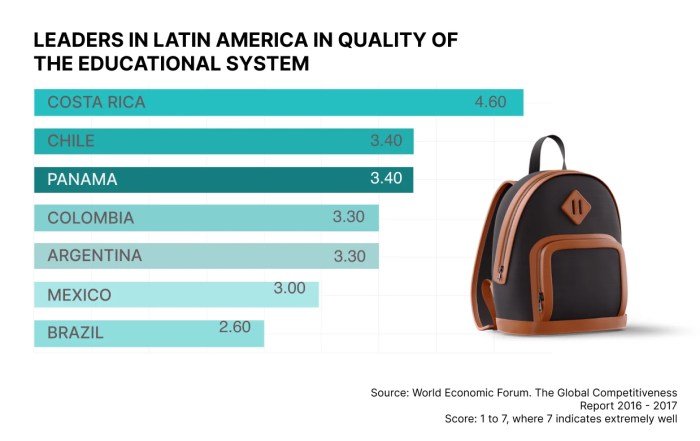Software development latin america – Latin America is experiencing a rapid surge in its software development sector, transforming from a region primarily focused on outsourcing to a vibrant ecosystem of innovation and technological advancement. This growth is driven by a confluence of factors, including a burgeoning talent pool, increasing government support, and a growing demand for tech solutions both domestically and internationally. This article delves into the intricacies of Latin American software development, exploring its strengths, challenges, and future prospects.
The Rise of Latin American Tech Talent
One of the key drivers behind Latin America’s software development boom is its vast and increasingly skilled workforce. Universities across the region are producing a steady stream of graduates proficient in various programming languages and technologies. Furthermore, a strong emphasis on STEM education is fostering a culture of technological literacy, creating a fertile ground for future developers. This talent pool is not only numerically significant but also increasingly competitive, with many Latin American developers possessing a strong command of English and a proven track record of successful projects.
Key Skills and Technologies
- Java: Remains a highly sought-after skill, particularly for enterprise applications.
- Python: Growing in popularity for data science, machine learning, and web development.
- JavaScript: Essential for front-end web development and increasingly important for back-end development (Node.js).
- .NET: Widely used for enterprise applications and particularly strong in certain regions.
- PHP: Still relevant for web development, though its dominance is waning compared to newer technologies.
- Mobile Development (iOS and Android): High demand for developers proficient in native and cross-platform frameworks like React Native and Flutter.
- Cloud Computing (AWS, Azure, GCP): Expertise in cloud platforms is becoming increasingly crucial.
- Data Science and Machine Learning: A rapidly growing area with significant opportunities.
Prominent Software Development Hubs in Latin America
While the entire region is experiencing growth, certain cities and countries have emerged as prominent software development hubs. These locations offer a combination of skilled talent, favorable business environments, and access to infrastructure.
Leading Countries and Cities:
- Brazil (São Paulo, Rio de Janeiro, Belo Horizonte): The largest economy in Latin America, Brazil boasts a substantial software development industry with a large and diverse talent pool.
- Mexico (Mexico City, Guadalajara, Monterrey): Mexico’s proximity to the United States and its growing tech sector make it an attractive location for software development.
- Argentina (Buenos Aires): Known for its strong academic institutions and a highly skilled workforce, Argentina is a significant player in the Latin American software development landscape.
- Colombia (Medellín, Bogotá): Colombia has experienced rapid growth in its tech sector, attracting significant foreign investment.
- Chile (Santiago): Chile’s stable economy and focus on innovation have contributed to its growing software development industry.
Challenges Facing Latin American Software Development
Despite its considerable strengths, the Latin American software development sector faces several challenges. Addressing these issues is crucial for ensuring continued growth and competitiveness.
Key Challenges:, Software development latin america
- Infrastructure Gaps: While improving, infrastructure in some regions remains a constraint, particularly regarding reliable internet access and power supply.
- Brain Drain: Highly skilled developers sometimes seek opportunities in more developed countries, leading to a loss of talent.
- Bureaucracy and Regulations: Navigating bureaucratic processes can be challenging for businesses, potentially hindering growth.
- Digital Divide: Unequal access to technology and education exacerbates existing inequalities, limiting opportunities for many.
- Currency Fluctuations: Economic instability and currency fluctuations can impact the profitability of software development projects.
Government Initiatives and Support
Recognizing the potential of the software development sector, many Latin American governments are implementing initiatives to foster growth and attract investment. These initiatives often include:

Source: waverleysoftware.com
- Investment in Education and Training Programs:
- Tax Incentives and Subsidies for Tech Companies:
- Development of Tech Parks and Incubators:
- Collaboration with International Organizations:
The Future of Software Development in Latin America: Software Development Latin America
The future of software development in Latin America appears bright. Continued investment in education, infrastructure, and supportive government policies will further fuel growth. The region’s strong talent pool, coupled with its increasing technological maturity, positions it to become an even more significant player in the global software development market. The increasing adoption of agile methodologies, the rise of nearshore outsourcing, and the growing demand for specialized skills like AI and machine learning will continue to shape the industry’s trajectory.

Source: turnkeystaffing.com
Frequently Asked Questions (FAQ)
- Q: What are the most in-demand programming languages in Latin America? A: Java, Python, JavaScript, and .NET are consistently high in demand, along with skills in mobile development and cloud computing.
- Q: Is it cheaper to outsource software development to Latin America? A: Generally, yes, compared to North America or Europe, but costs vary depending on location and specific skills required.
- Q: What are the biggest challenges for software developers in Latin America? A: Infrastructure gaps, brain drain, bureaucracy, and the digital divide are significant challenges.
- Q: Which Latin American countries are best for software development outsourcing? A: Brazil, Mexico, Argentina, Colombia, and Chile are all significant players, each offering different strengths.
- Q: What is the future outlook for the Latin American software development industry? A: The outlook is positive, with continued growth expected driven by talent, investment, and government support.
Resources
- Statista – Software Development in Latin America
- PwC – Tech Industry Outlook (Includes relevant Latin American data)
- (Add other relevant links here)
Call to Action
Are you interested in exploring the opportunities presented by Latin America’s dynamic software development sector? Contact us today to discuss your project needs and learn how we can connect you with top-tier talent in the region.
Helpful Answers
What are the most popular programming languages used in Latin American software development?
While usage varies by country and company, popular languages include Java, JavaScript, Python, and C#.
What are the biggest challenges facing software developers in Latin America?

Source: mirrorreview.com
Challenges include infrastructure limitations in some areas, competition for talent, and navigating sometimes complex regulatory environments.
Are there any specific niches or specializations within Latin American software development that are particularly strong?
Several countries excel in specific areas, such as game development in certain regions or fintech solutions in others. The strengths vary regionally.
What are the major cities or regions in Latin America that are considered hubs for software development?
Major hubs include Buenos Aires, São Paulo, Mexico City, Bogotá, and Santiago, but many other cities are rapidly emerging.
